Guercino
| Guercino | |
|---|---|
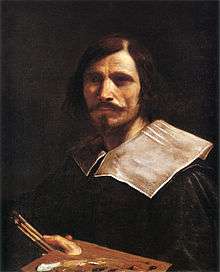 Self portrait, c. 1635 | |
| Born |
Giovanni Francesco Barbieri February 8, 1591 Cento |
| Died |
December 22, 1666 (aged 75) Bologna |
| Nationality | Italian |
| Known for | Painting |
| Movement | Baroque |
Giovanni Francesco Barbieri (February 8, 1591 – December 22, 1666), best known as Guercino,[1] or il Guercino [ɡwerˈtʃiːno], was an Italian Baroque painter and draftsman from the region of Emilia, and active in Rome and Bologna. The vigorous naturalism of his early manner is in contrast to the classical equilibrium of his later works. His many drawings are noted for their luminosity and lively style.
Biography
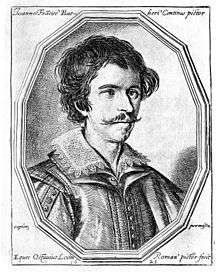
_-_Christ_and_the_Woman_of_Samaria_-_Google_Art_Project.jpg)
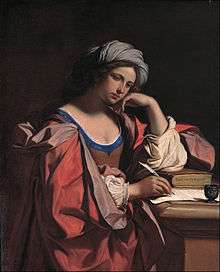
Giovanni Francesco Barbieri was born in Cento, a village between Bologna and Ferrara. At an early age he acquired the nickname Guercino (Italian for 'squinter') because he was cross-eyed.[2] Mainly self-taught, at the age of 16, he worked as apprentice in the shop of Benedetto Gennari, a painter of the Bolognese School.[3] By 1615, he moved to Bologna, where his work was praised by Ludovico Carracci. Guercino painted two large canvases, Elijah Fed by Ravens and Samson Seized by Philistines, for Cardinal Serra, a Papal Legate to Ferrara. These paintings have a stark naturalist Caravaggesque style, although it is unlikely that Guercino saw any of the Roman Caravaggios first-hand.
The Arcadian Shepherds (Et in Arcadia ego) was painted in 1618 at the same time of The Flaying of Marsyas by Apollo in Palazzo Pitti. Its dramatic composition is typical of Guercino's early works, which are often tumultuous.[4] He often claimed that his early style was influenced by a canvas of Ludovico Carracci that he saw in the Capuchin church in Cento. Some of his later works are closer to the style of his contemporary Guido Reni, and are painted with more lightness and clearness.
Career

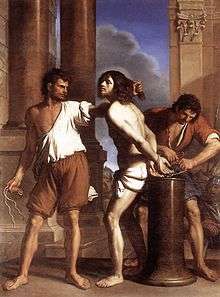
Guercino was recommended by Marchese Enzo Bentivoglio to the newly elected Bolognese Ludovisi Pope, Pope Gregory XV in 1621.[5] The years he spent in Rome, 1621–23, were very productive. From this period are his frescoes Aurora at the casino of the Villa Ludovisi, the ceiling in San Crisogono (1622) of San Chrysogonus in Glory, the portrait of Pope Gregory XV (now in the Getty Museum, and The Burial of Saint Petronilla or St. Petronilla Altarpiece for the Vatican (now in the Museo Capitolini), which is considered his masterpiece.
After the death of Gregory XV, Guercino returned to his hometown. In 1626, he began his frescoes in the Duomo of Piacenza. The details of his career after 1629 are well documented in the account book, the Libro dei Conti di Casa Barbieri, that Guercino and his brother Paolo Antonio Barbieri kept updated, and which has been preserved.[6] Between 1618 and 1631, Giovanni Battista Pasqualini produced 67 engravings that document the early production of Guercino, which is not included in the Libro dei Conti.[7] In 1642, following the death of Guido Reni, Guercino moved his busy workshop to Bologna and become the city's principal painter. In 1655, the Franciscan Order of Reggio paid him 300 ducats for the altarpiece of Saint Luke Displaying a Painting of the Madonna and Child (now in Nelson-Atkins Museum of Art, Kansas City).[8] The Corsini also paid him 300 ducats for the Flagellation of Christ painted in 1657.
Guercino was remarkable for the extreme rapidity of his executions: he completed no fewer than 106 large altarpieces for churches, and his other paintings amount to about 144. He was also a prolific draftsman. His production includes many drawings, usually in ink, washed ink, or red chalk. Most of them were made as preparatory studies for his paintings, but he also drew landscapes, genre subjects, and caricatures for his own enjoyment. Guercino's drawings are known for their fluent style in which "rapid, calligraphic pen strokes combined with dots, dashes, and parallel hatching lines describe the forms".[9] Guercino continued to paint and teach until his death in 1666, amassing a notable fortune. As he never married, his estate passed to his nephews and pupils, Benedetto Gennari II and Cesare Gennari.[2] Other pupils include Giulio Coralli,[10] Giuseppe Bonati of Ferrara,[11] Cristoforo Serra of Cesena,[12] Father Cesare Pronti of Ferrara,[13] Sebastiano Ghezzi,[14] Sebastiano Bombelli,[15] Lorenzo Bergonzoni of Bologna,[16] Francesco Paglia of Brescia.,[17] Benedetto Zallone of Cento, Bartolomeo Caravoglia,[18] and Matteo Loves.
Works
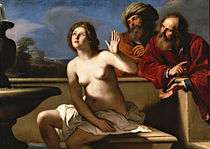 Susanna and the Elders, 1617
Susanna and the Elders, 1617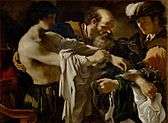 Return of the Prodigal Son, 1619
Return of the Prodigal Son, 1619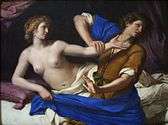 Joseph and Potiphar's Wife, 1649, National Gallery of Art
Joseph and Potiphar's Wife, 1649, National Gallery of Art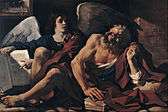 Saint Matthew and the Angel, 1622
Saint Matthew and the Angel, 1622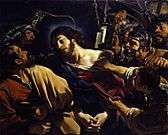 Capturing Christ, 1621
Capturing Christ, 1621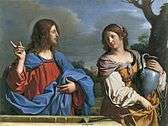 Christ and the Woman of Samaria II
Christ and the Woman of Samaria II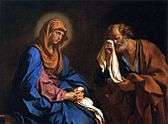 St Peter Weeping before the Virgin, 1647
St Peter Weeping before the Virgin, 1647 Mars with Cupid, 1649
Mars with Cupid, 1649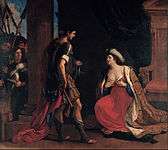 Cleopatra and Octavian, 1649
Cleopatra and Octavian, 1649.jpg) Atlas holding up the celestial globe, 1646
Atlas holding up the celestial globe, 1646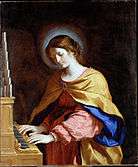 St. Cecilia, 1649
St. Cecilia, 1649_-_David_with_the_Head_of_Goliath_-_Google_Art_Project.jpg) David with the Head of Goliath, circa 1650
David with the Head of Goliath, circa 1650- The Vocation of Saint Aloysius Gonzaga, 1650
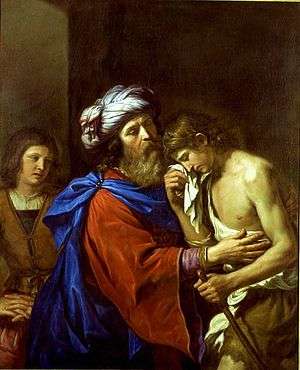 The Return of the Prodigal Son, 1651
The Return of the Prodigal Son, 1651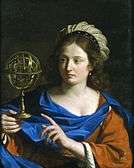 Personification of Astrology, ca. 1650–55, Blanton Museum of Art, Texas
Personification of Astrology, ca. 1650–55, Blanton Museum of Art, Texas_c._1768.jpg) King David, 1651
King David, 1651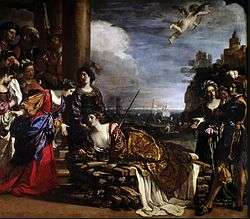 La morte di Didone, 1631
La morte di Didone, 1631
Exhibitions
The exhibition Guercino. Triumph of the Baroque. Masterpieces of Cento, Rome and Polish collections, displayed at the National Museum in Warsaw from September 2013 to February 2014.[19][20][21][22]
Notes
- ↑ "Beside the easel". besidetheeasel.blogspot.se. Retrieved 14 September 2017.
- 1 2 "Oxford Art Online: Guercino". Oxford University Press. Missing or empty
|url=(help) - ↑ Griswold 1991, p. 6
- ↑ Griswold 1991, p. 13
- ↑ Lawrence Gowing, ed., Biographical Encyclopedia of Artists, v.2 (Facts on File, 2005): 291.
- ↑ Griswold 1991, p. 35
- ↑ M. Fiammenghi, L. Cremonini, E. Cavalleri, F. Gozzi, Sacro e profano nelle Incisioni da Guercino, Bologna, Culturalia, 2006
- ↑ "Guercino's Saint Luke Displaying a Painting of the Virgin". Smarthistory at Khan Academy. Retrieved March 15, 2013.
- ↑ Griswold 1991, p. 36
- ↑ Orlandi, Pellegrino Antonio; Guarienti, Pietro (1719), Abecedario pittorico, Naples, p. 265
- ↑ Orlandi, page 207.
- ↑ Orlandi, page 120.
- ↑ Orlandi, page 350.
- ↑ Orlandi, page 399.
- ↑ Orlandi, page 397.
- ↑ Orlandi, page 294.
- ↑ Orlandi, page 171.
- ↑ Lanzi, Luigi (1847). Thomas Roscoe (translator), ed. History of Painting in Italy; From the Period of the Revival of the Fine Arts to the End of the Eighteenth Century. III. London; Original from Oxford University, Digitized January 2007: Henry G. Bohn. pp. 309–310.
- ↑ The exhibit comprised 80 works, including 33 paintings by Guercino. The exhibition included paintings from the Pinacoteca, churches and palaces of Cento (mnw) as well as the Arcadian Shepherds (Et in Arcadia ego) from the Barberini collection (legitymizm) and the monumental Crucifixion with St Elizabeth of Hungary and St Frances of Rome, the altar painting from the Potocki Chapel in the Wawel Cathedral.(artinfo) The exhibition, curated by Boris Kudlička, was the most extensive European presentation of work by Guercino outside of his home country.(legitymizm)
- ↑ "Guercino. Triumf baroku. Arcydzieła z Cento, Rzymu i kolekcji polskich". www.new.mnw.art.pl. Retrieved 20 May 2014.
- ↑ "Guercino. Triumf baroku". www.legitymizm.org. Retrieved 20 May 2014.
- ↑ "Guercino. Triumf baroku". www.artinfo.pl. Retrieved 20 May 2014.
References

- Marchese Antonio Bolognini Amorini (1843). "Parte Quinta". Vite de Pittori ed Artifici Bolognesi. Tipografia Governativa alla Volpe, Bologna. pp. 223–272.
- Griswold, William M. (Spring 1991). "Guercino". Metropolitan Museum of Art Bulletin. 48(4): 5–56.
External links
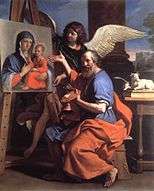 | |
|
|
| Wikimedia Commons has media related to Guercino. |
| Wikisource has the text of the 1911 Encyclopædia Britannica article Barbieri, Giovanni Francesco. |
- Paintings by Guercino on the Web Gallery of Art
- Getty exhibition of Guercino drawings
- Encyclopædia Britannica, Il Guercino
- (in Italian) Short biography
- Pinacoteca Civica Il Guercino
- Virtual exhibition "Guercino a Fano" in high resolution
- Jusepe de Ribera, 1591-1652, an exhibition catalog from The Metropolitan Museum of Art (fully available online as PDF), which contains material on Guercino (see index)
- Velázquez , an exhibition catalog from The Metropolitan Museum of Art (fully available online as PDF), which contains material on Guercino (see index)